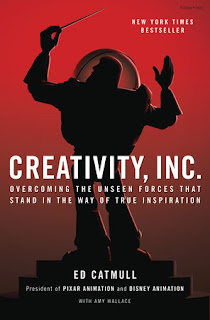 |
| Book cover |
The very beginning of this book does capture the early history of Pixar up through the release and success of Toy Story. The only management lesson I think it was trying to tell is something like this: Get a group of talented people together, give them the honest mandate that quality is priority and you have a gamble. Maybe magic will happen, maybe everything flails around and nothing gets built. Like I said, this book isn't about that initial success.
When a book talks about something I know about, in this case management, I look for it to help me put a name or framework to practices that I have found successful. I often know something works and can usually replicate it, but - when I don't fully understand something, I find myself repeating a ritual, instead of understanding the essential steps.
When I read How to Make Friends and Influence People, for example, I learned a lot about what I already did right, but I learned even more about the essentials. I was able to demystify the things I did right, and stop wasting effort on things that were needless parts of my repeated ritual ... things that most likely annoyed people.
Creativity, Inc. was written to let me know that the rituals I repeat to try to repeat a successful behavior may be more harmful that helpful, with examples (and a lot of them). There are absolutely successful behaviors described here, but the big theme is learning to find balance in agility. That is, change is necessary while stagnation is certain death. Yet, change without balance is chaos. Creativity without deadline is unlikely to ever complete, yet deadline without flexibility will lead to rote repetition, burnout or both. Trust your people, but hold them accountable. Accountability means that they must have the power of open and constructive input.
This book has a very clever style of writing. It talks about a number of management strategies illustrated through a memoir style, The Making Of ..., most of Pixar's movies. That is the story of how Toy Story 2 was made is also a cautionary tale of employee burnout. The making of Inside Out is a tale about how constructive feedback works, while the making of a story that ended up cancelled entirely is a tale about how to feedback done wrong, or too little, does lead to failure. There is also a bit of interesting insight into Steve Jobs in here.
Yes, I recommend this book if you, like me, are really into Pixar. Definitely read this if you are a Steve Jobs completist. I recommend this book if you want to read good narrative advice about running a creative and productive team. Skip it if neither management nor animation are of interest to you. Yet, even from a story perspective, a good half of this book is great narrative storytelling wrapping around a lesson on team management.
I received this book as a Christmas gift from my son, who knows how much I love Pixar.
Creativity Inc
Business Management
Random House
Released: 8 April 2014
Hardcover, 368 pages